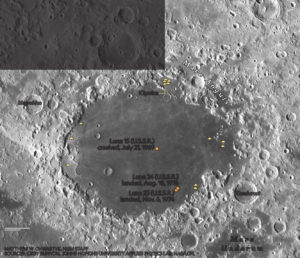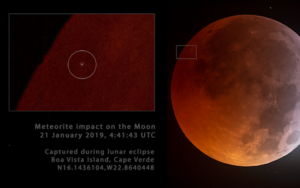by Massachusetts Institute of Technology, Jul 7, 2022 in ScienceDaily
The moon sustained twice as many impacts as can be seen on its surface, scientists find.
Around 4.4 billion years ago, the early solar system resembled a game of space rock dodgeball, as massive asteroids and comets, and, later, smaller rocks and galactic debris pummeled the moon and other infant terrestrial bodies. This period ended around 3.8 billion years ago. On the moon, this tumultuous time left behind a heavily cratered face, and a cracked and porous crust.
Now MIT scientists have found that the porosity of the moon’s crust, reaching well beneath the surface, can reveal a great deal about the moon’s history of bombardment.
In a study appearing in Nature Geoscience, the team has shown through simulations that, early on in the bombardment period, the moon was highly porous — almost one-third as porous as pumice. This high porosity was likely a result of early, massive impacts that shattered much of the crust.
Scientists have assumed that a continuous onslaught of impacts would slowly build up porosity. But surprisingly, the team found that nearly all the moon’s porosity formed rapidly with these massive imapcts, and that the continued onslaught by smaller impactors actually compacted its surface. These later, smaller impacts acted instead to squeeze and compact some of the moon’s existing cracks and faults.
From their simulations, the researchers also estimated that the moon experienced double the number of impacts as can be seen on the surface. This estimate is lower than what others have assumed.
“Previous estimates put that number much higher, as many as 10 times the impacts as we see on the surface, and we’re predicting there were fewer impacts,” says study co-author Jason Soderblom, a research scientist in MIT’s Department of Earth, Atmospheric and Planetary Sciences (EAPS). “That matters because that limits the total material that impactors like asteroids and comets brought to the moon and terrestrial bodies, and gives constraints on the formation and evolution of planets throughout the solar system.
…
by Kip Hansen, Apr 30, 2021 in WUWT
Dr. Judith Curry sent out a tweet about this article at The Conversation: “This supermoon has a twist – expect flooding, but a lunar cycle is masking effects of sea level rise“. The piece is written by Brian McNoldy, a Senior Research Associate, University of Miami and written in conjunction with Covering Climate Now — the climate news propaganda effort headed up by the Columbia Journalism Review and The Guardian. The Conversation is a member of Covering Climate Now and a search of their website shows they have published, so far, a total of 86 articles in cooperation with that organization.
McNoldy does a good job explaining what Lunar Nodal Cycle is and how it affects apparent local Relative Sea Level Rise
…
…
Bottom Line:
Miami, Florida has high tide flooding because much of Miami Beach (particularly) is built within a foot or two of normal high tides, and some portions are below normal high tides. So, of course, Miami will experience tidal flooding again at these predicted higher tides. For Miami’s real Sea Level story, see my earlier essay: Miami’s Vice.
by Harvard-Smithsonian Center for Astrophysics, Nov 23, 2020 in ScienceDaily
…
Resources like water and iron are important because they will enable future research to be conducted on, and launched from, the moon. “You don’t want to bring resources for mission support from Earth, you’d much rather get them from the Moon. Iron is important if you want to build anything on the moon; it would be absurdly expensive to transport iron to the moon,” said Elvis. “You need water to survive; you need it to grow food — you don’t bring your salad with you from Earth — and to split into oxygen to breathe and hydrogen for fuel.”
Interest in the moon as a location for extracting resources isn’t new. An extensive body of research dating back to the Apollo program has explored the availability of resources such as helium, water, and iron, with more recent research focusing on continuous access to solar power, cold traps and frozen water deposits, and even volatiles that may exist in shaded areas on the surface of the moon. Tony Milligan, a Senior Researcher with the Cosmological Visionaries project at King’s College London, and a co-author on the paper said, “Since lunar rock samples returned by the Apollo program indicated the presence of Helium-3, the moon has been one of several strategic resources which have been targeted.”
…
by D. Middleton, March 24, 2020 in WUWT
One of the things I love about writing for Watts Up With That, is the fact that reader comments often inspire me to research and write subsequent posts. In my recent post about the origins of the Moon, one commentator suggested that the rate of lunar recession (tidal acceleration) indicated that the Earth was much younger than 4.5 billion years old and/or somehow disproved the geological Principle of Uniformitarianism. I didn’t give much thought to my reply. I simply calculated the distance from the Earth to the Moon 1 billion and 4.5 billion years ago. The Moon is currently receding (moving away) from the Earth at a rate of about 3.8 cm/yr. This has been directly measured with lasers.
At 3.8 cm/yr, the Moon would have been 215,288 miles away from Earth a billion years ago. It is currently an average of 238,900 miles away. At 3.8 cm/yr, it still would have been 132,646 miles away 4.5 BY.
If the Moon did did originate from a collision with Earth, it would have been a lot closer to Earth 4.5 BY than 100,000 miles.
…
…
by R.G. Andrews, December 13, 2019 in NationalGeography
Scientists scouring the lunar surface for clues to past impact rates found a bonus feature that has geologists “thoroughly confused.”
Sometime after the solar system formed 4.6 billion years ago, a projectile slammed into Earth’s youthful moon and formed the 620-mile-wide basin known as the Crisium basin. No one knows exactly when this impact happened, but for decades scientists have been trying to solve the puzzle as part of a larger debate over whether the moon and, by proxy, Earth endured a period of frenzied meteor bombardment in their early histories.
Now, scientists scouring the region say they’ve spotted a crater within the basin that appears to contain pristine impact melt, a type of volcanic rock that can act like a definitive geologic clock. If future astronauts or a robot could obtain a sample and tease out its age, that may help reveal what was happening on Earth during the primordial period when life first emerged on our planet.
And, as an added bonus, the discovery comes with an intriguing mystery: The basin also holds a geologic blister the size of Washington, D.C., that’s unlike anything else seen in the solar system. As the team reports in an upcoming paper in the Journal of Geophysical Research: Planets, this volcanic lump appears to have been inflated and cracked by peculiar underground magmatic activity that the researchers can’t currently explain.
“I’m thoroughly confused by it,” says Clive Neal, an expert in lunar geology at the University of Notre Dame who was not involved with the new research.

…
by A. Watts, February 15, 2019 in WUWT
A provocative hypothetical question: What if the Moon was not there? Video follows.
This giant rock lights up the night and can even change colors. So what would we do without it? Would we all need night vision goggles? How would it affect the ocean tides? Our seasons? Or our sleep cycles? Or would the consequences be far more drastic?
As the closest celestial body to our planet, the moon exerts a gravitational pull that governs much of what happens here on Earth Take the sea, for example. If you like surfing, you can thank the moon when the moon’s gravitational pull tugs on our spinning Earth, the oceans respond, giving us high tides in some parts of the world, and low tides elsewhere.
…
by Anthony Watts, January 22, 2019 in WUWT
This is a treat. On Jan. 21st, a meteoroid slammed into the Moon. We know this because many amateur astronomers witnessed the explosion and recorded video and photos. The fireball was visible against the shadowy backdrop of a total lunar eclipse. Video of the event follows.
We know this because many amateur astronomers witnessed or photographed the explosion. Petr Horálek was one of them; he captured the fireball from Boa Vista, one of the islands of Cape Verde …
…

by Shaui Li et al., August 20, 2018 PNAS
We found direct and definitive evidence for surface-exposed water ice in the lunar polar regions. The abundance and distribution of ice on the Moon are distinct from those on other airless bodies in the inner solar system such as Mercury and Ceres, which may be associated with the unique formation and evolution process of our Moon. These ice deposits might be utilized as an in situ resource in future exploration of the Moon.
…
La géologie, une science plus que passionnante … et diverse


